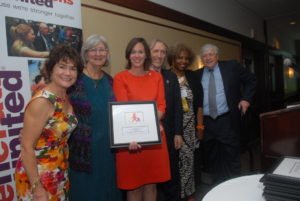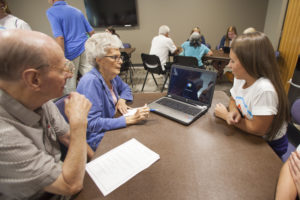Provost’s Council for Engagement spotlight: Christine Fruhauf
by Jim Beers | March 7, 2017 11:26 AM
 [1]
[1]The newly formed Provost’s Council for Engagement[2] is made up of a dozen faculty members representing all eight colleges and Morgan Library. Council members serve as champions for advancing the practice and recognition of engaged scholarship as fully embedded within CSU’s core teaching, research, and service missions.
Each month we will profile a different member of the Council, who will in their own words help to showcase the diversity of engaged scholarship across campus, as well as the impact of this work on communities and the university. Last month’s profile[3] of council member Martin Carcasson kicked off the year-long series, and this month we meet Christine Fruhauf, associate professor, Department of Human Development and Family Studies[4], College of Health and Human Sciences[5]. Fruhauf discusses why she became a member of the council, what she hopes to accomplish, and how engagement affects her students.
What, in your opinion, is “faculty engagement”?
“In my opinion, I believe faculty engagement is the opportunity to bridge research, teaching and service to benefit students’ learning, answer important questions related to programs of research, and support communities as they engage in solving social problems. Faculty engagement is time-consuming and, yet, probably one of the most rewarding aspects about my role at CSU.
As an engaged faculty member, I’ve not only reaped the benefits as it relates to my research, but perhaps more importantly, I’ve seen students learn important critical skills during their service-learning experiences in my gerontology courses, and I’ve watched community nonprofits benefit from working with these students. For example, I’ve connected the Grand Family Coalition (GFC), Inc. with a number of students over the past three years.
After my course has ended, and even after students have graduated from CSU, many of these students continue to volunteer their time by engaging with the GFC. To me, this ‘passing on’ the philosophy of engagement to my students as they become young professionals in our communities is extremely rewarding.”
How have you, your program or students benefitted from what you have learned as an engaged faculty member? And, has there been any sort of reciprocity with the communities outside of CSU that you have been involved with?
“During my sabbatical leave, I focused my training on learning about methods in conducting Community-Based Participatory Research. The reason I focused on this research method was I had minimal knowledge of CBPR and yet through my partnership with the Larimer County Alliance for Grandfamilies and CSU Extension I was engaging in this form of research. What I learned during my sabbatical is there are nine principles of CBPR. One principle, in particular, is the driving force for how I approach engagement of my research: ‘CBPR facilitates a collaborative, equitable partnership in all phases of research, involving an empowering and power-sharing process that attends to social inequalities’ (Israel, Eng, Schulz & Parker).
To the extent possible in my projects, I talk with LCAG members and grandparents about the research questions they believe are important to ask: how they would benefit from working with students and how students would benefit from working with them. I also discuss ways to collect data, recruit participants, and how and where to disseminate results that are beneficial to not only other researchers but also service providers and families in our community.
In the end, guided by CBPR methods, I engage in a process of shared decision-making, allowing for an avenue of building trust. Trust is a key component in CBPR, and, in my belief, building and sustaining trust between the university and the community is necessary to foster and advance university engagement.”
Why are you involved with this council and how does it relate to your work or research?
“It is an exciting time on campus, and I’m really impressed by Colorado State University’s leadership addressing university engagement and the willingness of CSU colleagues to dive in and tackle difficult questions as it relates to the Council’s mission. I’m involved with the Council because I truly believe in the land-grant mission of CSU and I want to work with a team of colleagues to advance CSU’s presence as the first place local, state, national and international partners turn to for engagement opportunities.
 [6]
[6]My area of research addresses aging families. Early in my career at CSU I became involved in the LCAG, which formed in 2007 from a grassroots effort driven by three grandmothers seeking assistance from local community agencies, only to find support from the Larimer County Extension Office[7]. The LCAG’s earliest efforts focused on bringing grandparents, professionals, university faculty/students and other allies together to discuss the needs of grandparents raising grandchildren. We also address how the community can best care for ‘grandfamilies.’
At the end of March, it will be 10 years since the LCAG officially formed, and we still meet monthly. I can say with certainty that through the LCAG I have seen university-community engagement at its finest. For example, I work closely with colleagues across campus to engage students through service-learning opportunities, write grant proposals and co-author papers and presentations with LCAG partners.
Finally, I also truly believe my engagement with the LCAG and CSU Extension[8] system was the catalyst to support my current funding from USDA/NIFA Children Youth and Families At-Risk – Sustainable Community Project. This project is a multistate collaboration with faculty and Extension colleagues at the University of Hawaii at Mano and is a systems-based intervention for vulnerable grandparent-headed families.
The tripartite intervention is based upon family resilience theory and focuses on strengthening self-care and parenting skills in custodial grandparents, developing communication and leadership skills in grandchildren, and increasing the ability of service providers to meet grandfamilies’ needs. This truly is a team effort with strong ties between two campuses, extension systems and many communities.”
What do you hope the council is able to accomplish?
“The council has met a few times this academic year and it is clear to me that there are a number of goals, all equally important, for the Council to accomplish. However, I believe the council should begin with focusing on faculty support. For example, if CSU can recruit and/or cultivate, retain and honor faculty whose passion is engagement in their teaching, research and service, then I believe the council has accomplished an important set of goals.
Supporting faculty’s role in university engagement will benefit their sustained programs of research, our students’ academic and practical learning, and advance local, state, national and international community initiatives. Thus, moving CSU forward in its land-grant mission and focus towards university engagement.”
Reference –
Israel, B. A., Eng, E., Schulz, A. J., & Parker, E. A. (2005). Introduction to methods in community-based participatory research for health. In B.A. Israel, E. Eng, A. J., Schulz, & E. A. Parker (Eds.) Methods in community-based participatory research for health (pp. 3-29).San Francisco, CA: Jossey-Bass.
- [Image]: http://source.colostate.edu/wp-content/uploads/2017/03/Provosts-Council-on-Engagement-Profile-Fruhauf-group-1.jpg
- Provost’s Council for Engagement: http://source.colostate.edu/provosts-council-engagement-support-faculty-efforts/
- profile: http://source.colostate.edu/provosts-council-engagement-member-martin-carcasson/
- Department of Human Development and Family Studies: http://www.hdfs.chhs.colostate.edu/
- College of Health and Human Sciences: http://www.chhs.colostate.edu/
- [Image]: http://source.colostate.edu/wp-content/uploads/2017/03/Provosts-Council-on-Engagement-Profile-Fruhauf_mentors.jpg
- Larimer County Extension Office: http://larimer.colostate.edu/
- CSU Extension: http://extension.colostate.edu/
Source URL: https://source.colostate.edu/provosts-council-engagement-spotlight-christine-fruhauf/
Copyright ©2024 SOURCE unless otherwise noted.